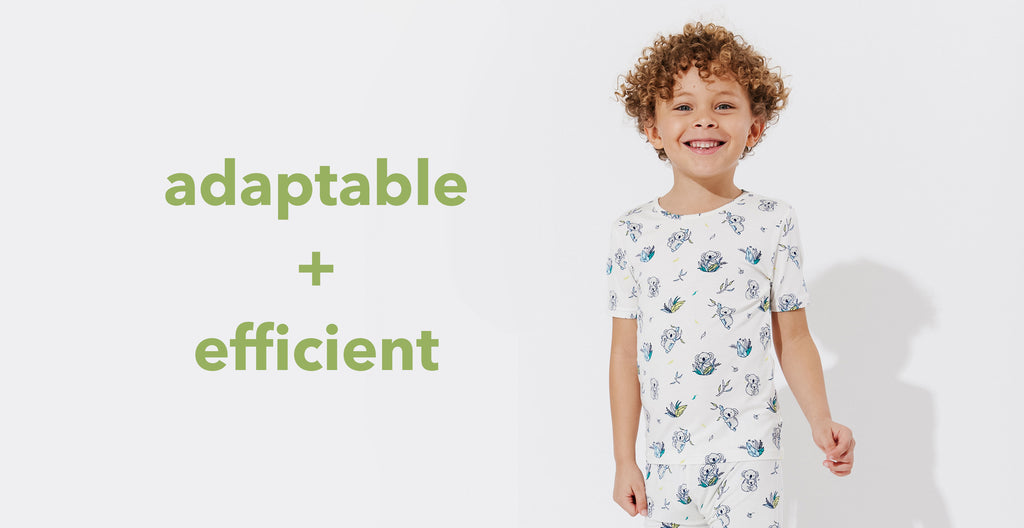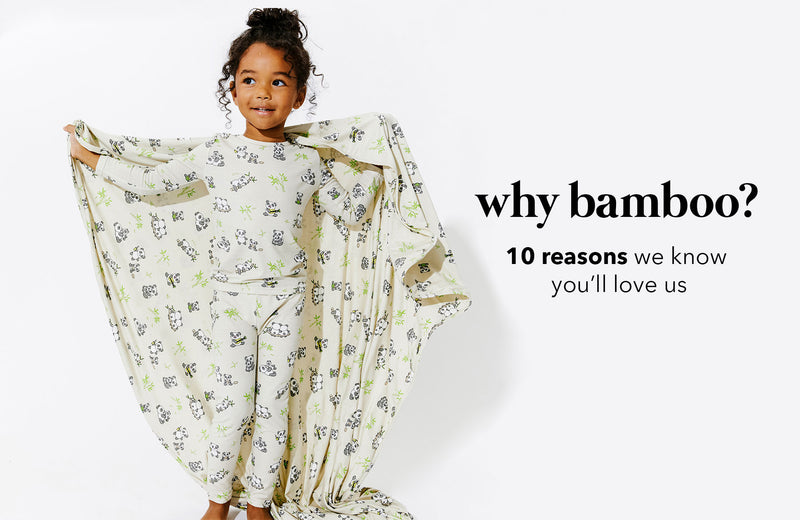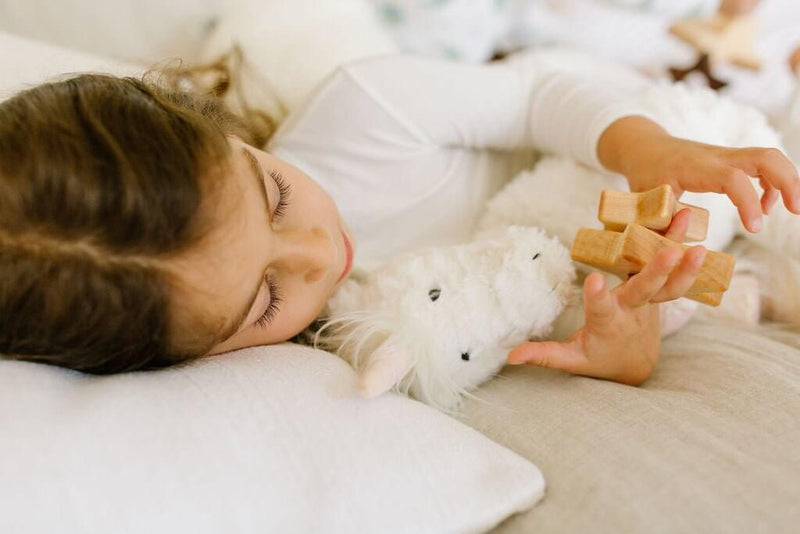Saving The Planet One Bamboo Pajama At A Time

Amidst the quest for an eco-friendly world, bamboo shines as a sustainable superstar! 🌱💚 Embrace the green revolution with bamboo products, including pajamas that blend comfort and conscience.
By choosing bamboo, you're making a positive impact on the planet, one cozy step at a time. Save the planet, stitch by stitch, with bamboo pajamas! 🌍🌿 Embrace sustainable slumber and join our mission to make a positive impact. Our bamboo pajamas are not only luxuriously soft and comfortable but also eco-friendly. Sleep well knowing you're making a difference, one cozy night at a time.
But first, what does it mean to be environmentally friendly?
Being environmentally friendly means adopting a lifestyle that prioritizes the well-being of our planet. It involves making conscious choices and taking actions that minimize harm to the environment, reduce waste, conserve resources, and promote sustainability. By embracing eco-friendly practices, we strive to protect and preserve the Earth, ensuring a healthier and more sustainable future for generations to come. It's a collective responsibility to take steps towards reducing our ecological footprint and safeguarding the natural world. Together, we can make a positive difference and create a greener and more harmonious world for all. 🌍💚
In the realm of sustainability, there is ongoing debate regarding the overall impacts of bamboo. However, this article will provide an insightful comparison of both the pros and cons, allowing you to evaluate how bamboo can offer significant benefits. By exploring various aspects such as resource efficiency, carbon footprint, versatility, and more, you'll gain a comprehensive understanding of bamboo's potential advantages. Stay informed and make an informed choice as you navigate the intricacies of sustainability and eco-friendly alternatives. 🌱💡

Bamboo Itself
Bamboo is an incredibly diverse plant, with approximately 1,500 known species. While it originated in China, it has the ability to thrive in various regions around the world, except for extremely cold climates. (Bamboo Grove) This adaptability has contributed to its widespread cultivation and utilization in different environments.
One of the most fascinating aspects of bamboo is that it belongs to the grass family (Poaceae). Despite its tree-like appearance and impressive height, bamboo is technically classified as a grass. It is the only subfamily within the grass family to have diversified and evolved into forest-dwelling plants. This unique characteristic sets bamboo apart and showcases its distinctive role in the plant kingdom. (Lewis Bamboo)
The fact that bamboo is a grass with tree-like qualities further enhances its appeal as a sustainable and renewable resource. Its rapid growth and ability to regenerate make it an ideal choice for various applications, ranging from construction and textiles to culinary and decorative uses. Bamboo truly represents the harmonious balance between strength, versatility, and environmental consciousness. 🎋🌱
At Bellabu Bear, we understand the importance of creating clothing and pajamas that prioritize comfort, health, and sustainability. That's why we've harnessed the incredible properties of bamboo to craft our super comfortable and versatile garments.
Our bamboo clothing and pajamas offer a unique combination of benefits. First and foremost, bamboo fabric is exceptionally soft, providing a gentle touch against the skin. This makes it particularly suitable for individuals with sensitive skin conditions like eczema. In fact, we are proud to have received the Seal of Acceptance from the National Eczema Association (2023), acknowledging the skin-friendly nature of our bamboo products.
Not only is our bamboo clothing gentle on the skin, but it is also antibacterial. Bamboo possesses natural antimicrobial properties that inhibit the growth of bacteria, keeping your garments fresh and odor-free for longer durations. Additionally, bamboo fabric is highly breathable, allowing for better airflow and moisture-wicking, which helps regulate body temperature and keeps you comfortable throughout the day or night.
Furthermore, bamboo fabric has excellent insulating properties, making it suitable for various climates. It provides warmth in cooler temperatures while remaining breathable to prevent overheating. This adaptability makes our bamboo clothing and pajamas a reliable choice for year-round wear.
By choosing Bellabu Bear's bamboo clothing, you are not only prioritizing your comfort but also making an environmentally conscious decision. Bamboo is a sustainable resource that grows rapidly without the need for harmful chemicals, making it an eco-friendly alternative to conventional fabrics.
Experience the perfect blend of comfort, functionality, and sustainability with our bamboo clothing and pajamas. Embrace the Bellabu Bear brand and enjoy a new level of comfort that cares for your skin and the planet. 🐻🌿💚

Pros
Specific to how bamboo grows, there are many benefits here alone!
Bamboo's growth rate is truly remarkable and stands as one of its most impressive qualities. The fact that some bamboo species can grow as much as 1.5 inches per hour is astounding, showcasing its rapid growth potential. (Weeden)
Furthermore, bamboo's ability to regenerate from its existing root system eliminates the need for manual replanting. (Brundell) Once harvested, bamboo can sprout new shoots on its own, ensuring a continuous supply without the time and effort required for replanting. This regenerative property not only saves time but also reduces the resources and labor typically associated with replanting cycles.
These unique characteristics of bamboo make it an incredibly time-efficient resource. Its fast growth and natural regeneration contribute to its reputation as a sustainable and readily available material. Whether it's for construction, textiles, or other applications, bamboo's time-efficiency adds to its appeal as an eco-friendly choice. 🎍⏱️
One of the significant advantages of bamboo over cotton is its water efficiency. Bamboo requires significantly less water compared to cotton during its growth process. Studies indicate that bamboo requires approximately 1/3 of the water needed for cotton cultivation. (Nutricare)
This water-saving attribute of bamboo is particularly noteworthy considering the global water scarcity issues we face today. By choosing bamboo over cotton, we can conserve valuable water resources and redirect them to more critical uses such as drinking water, agriculture, and ecosystem preservation.
Furthermore, the lower water requirement of bamboo cultivation reduces the strain on local water supplies, making it a more sustainable option for regions facing water scarcity or drought conditions. The water efficiency of bamboo aligns with the principles of responsible water management and promotes sustainable agriculture practices.
By opting for bamboo-based products, such as clothing or other textiles, we can make a positive impact by reducing water consumption and contributing to water conservation efforts. Let's choose the eco-friendly path and make a difference for our planet's precious water resources. 💧
Indeed, the adaptability of bamboo to various climates is a significant advantage. Bamboo's ability to thrive in diverse environments allows for localized cultivation, which can have several positive environmental implications.
By having bamboo plantations in close proximity to fabric-making factories, transportation distances can be minimized. This reduces the need for long-distance transportation of raw materials, cutting down on fuel consumption and associated carbon emissions. The proximity between bamboo sources and manufacturing facilities creates a more streamlined and sustainable supply chain.
Reducing transportation distances not only lowers carbon emissions but also decreases the overall ecological footprint of the production process. It aligns with the principles of sustainable manufacturing and supports efforts to mitigate the impacts of global warming.
Furthermore, bamboo's natural ability to sequester carbon dioxide during its rapid growth adds to its environmental benefits. As a carbon-neutral material, bamboo can help offset carbon emissions, contributing to the fight against climate change and the planet's global warming problem.
By embracing the use of locally sourced bamboo for fabric production, we can promote regional sustainability, minimize transportation-related carbon emissions, and take significant steps towards addressing climate change. Let's harness the power of bamboo and its proximity advantages to create a more environmentally friendly and efficient industry. 🎋🌍💚
One of the remarkable qualities of bamboo is its natural resistance to pests and bacteria. Bamboo contains an antibacterial bio-agent called "bamboo kun," which grows within the bamboo cells. This unique property eliminates the need for pesticides or chemical treatments during bamboo cultivation. (Bamboo Grove)
The presence of bamboo kun in bamboo fabric has several benefits. Firstly, it makes bamboo fabric naturally resistant to bacteria, inhibiting the growth of odor-causing microbes and keeping the fabric fresh and clean for longer durations. This antibacterial property is retained even after the bamboo is processed into fabric, ensuring that the final product remains hygienic and free from unwanted microbial growth.
Furthermore, bamboo kun acts as a protective shield for the bamboo plant itself. It helps to keep bamboo shoots pest-free, preventing damage from insects and other critters that would typically pose a threat to the plant in its natural environment. This natural defense mechanism of bamboo reduces the reliance on chemical pesticides, making bamboo cultivation more environmentally friendly and sustainable.
By choosing bamboo-based products, such as bamboo fabric, we can enjoy the benefits of its inherent antibacterial properties. From hypoallergenic clothing to fresh-smelling towels and bedding, bamboo fabric offers a naturally clean and bacteria-resistant solution. Let's embrace the power of bamboo kun and experience the natural goodness of bamboo in our everyday lives. 🎍🌿💫

Harvesting
The harvesting process of bamboo is incredibly eco-friendly and leaves the surrounding ecosystem unharmed. Here's why:
Unlike traditional tree species that can take decades to mature, bamboo has a remarkably fast growth rate and can be harvested within 1 to 5 years, depending on the species. (Brundell) This rapid growth allows for a more sustainable and efficient utilization of resources.
When bamboo is harvested, it doesn't require the complete removal of the plant or its root system. Only the mature stalks are selectively cut, leaving the rest of the plant intact. This method of selective harvesting ensures that the bamboo grove remains undisturbed, allowing new shoots to emerge and continue the growth cycle.
The ability of bamboo to regenerate from its existing root system means that replanting is not necessary. This further minimizes the impact on the surrounding ecosystem and reduces the time and resources required for reestablishment.
By leaving the surrounding ecosystem unharmed, bamboo cultivation supports biodiversity and the preservation of natural habitats. The continuous growth and regeneration of bamboo contribute to a healthy and balanced ecosystem, promoting a sustainable environment for various plant and animal species.
Choosing bamboo-based products, such as bamboo fabric or furniture, allows us to support a more responsible and environmentally friendly approach to resource utilization. By embracing bamboo's easy and sustainable harvesting process, we can make a positive impact on the planet and ensure the well-being of ecosystems for future generations. 🌱🎋🌍
The soil health benefits associated with bamboo harvesting are remarkable.
When bamboo is harvested, the surrounding soil remains undisturbed. Unlike traditional tree harvesting, which often involves uprooting the entire tree, bamboo harvesting only involves selectively cutting mature stalks. This means that the root system of bamboo, which plays a vital role in soil stability and nutrient cycling, remains intact. (Brundell)
By leaving the soil undisturbed, the ecosystem surrounding the bamboo grove can continue to thrive. The existing plants and microorganisms in the soil can maintain their natural balance and interactions, promoting biodiversity and a healthy ecosystem.
The extensive root system of bamboo helps prevent soil erosion. The interconnected network of bamboo roots holds the soil together, reducing the risk of erosion caused by wind or water. This not only helps maintain soil fertility but also preserves nearby water bodies from sedimentation.
Additionally, bamboo has a remarkable ability to enrich the soil. As bamboo leaves naturally fall and decompose, they release nutrients back into the soil, enhancing its fertility. This nutrient cycling process supports the growth of other plants in the vicinity and contributes to overall ecosystem health.
By preserving soil health through bamboo cultivation practices, we can foster sustainable land management and preserve the natural balance of ecosystems. Choosing bamboo-based products promotes a more responsible approach to resource utilization, supporting a healthy and thriving environment. 🌱🌿🌍
Bamboo in its growing to harvesting process also repairs soil damaged by overgrazing and poor agricultural techniques. In a study of bamboo species in India, it’s reported that “On degraded soils, litter fall and fine roots of bamboo adds considerable amount of carbon and nutrients to the soil, which helps in improving soil health.” (R. Kaushal et al.)
Bamboo's root system plays a crucial role in earth stabilization and can help mitigate various environmental challenges, particularly in regions with heavy rainfall and monsoons. (Lewis Bamboo) By providing earth stabilization, bamboo contributes to a more resilient ecosystem and safeguards the surrounding areas from natural hazards associated with heavy rainfall. The ability of bamboo to prevent landslides, regulate water flow, and control erosion makes it an important ally in sustainable land management and climate resilience.

Oh, you thought we were done?
Bamboo offers numerous environmental benefits beyond its growth and harvesting. Here are some additional advantages of bamboo...
Bamboo's versatility is truly remarkable, and it can be utilized in various industries and applications such as; fabric, paper and packaging, construction and furniture, culinary and food products and traditional medicine. (Laidler)
If you’re surprised that bamboo can be used for construction, check out this fact... Bamboo's strength as a building material is truly impressive. With a tensile strength of 28,000 pounds per square inch (psi), it surpasses even mild steel, which typically measures 23,000 psi. (Lewis Bamboo)
Bonus fact! It is true that after the atomic bombing of Hiroshima in 1945, bamboo was one of the few plants that managed to survive and grow amidst the devastation. This remarkable ability to withstand extreme conditions further highlights the unique qualities of bamboo. (Brundell)
Bamboo is a remarkable plant when it comes to mitigating carbon emissions and contributing to environmental sustainability. Knowing that carbon dioxide emissions contribute to global warming, the world needs to be smart with the amount of trees we cut down a year. What if I tell you there’s a way we can collectively cut down carbon emissions by switching away from trees? Bamboo is the answer! Bamboo can both release more than 35% more oxygen than trees, and can absorb as much as 12 tonnes of carbon dioxide per hectare per year. (Laidler)
Bamboo's flame-resistant properties make it an excellent natural fire barrier, and its inclusion in forested areas can help protect against the devastating spread of wildfires. “Because [bamboo] contains large amounts of silicate acid, bamboo is abnormally flame resistant” (Weeden). Bamboo can help stop the spread of fire and save forests!
There’s a reason our brand features the panda. Pandas LOVE bamboo! The connection between bamboo and pandas is truly special. By promoting the growth and utilization of bamboo, we can play a vital role in supporting the survival of endangered giant pandas and the overall health of forest ecosystems. According to the World Wildlife Fund, “A panda’s diet is 99% vegetarian, which mostly includes bamboo roots, stems, shoots and leaves.” (WWF)
By embracing bamboo as a symbol of panda conservation and promoting its growth, we can make a positive impact on the survival of giant pandas and the health of forest ecosystems. Let's join forces to protect these incredible creatures and their natural habitats. 🐼🎍🌿

Cons
While bamboo itself has numerous environmental benefits and advantages, any drawbacks or negative impacts associated with bamboo are often a result of improper harvesting or production practices.
While some sources claim that bamboo can lead to monocultures and a loss in biodiversity, this is often a result of mismanagement or unsustainable farming practices rather than an inherent characteristic of bamboo itself. (Kogut)
In some regions, the rapid expansion of bamboo-only plantations may have been driven by the promise of financial incentives or the economic benefits associated with bamboo production. While this has led to an increase in bamboo cultivation, it's crucial to ensure that this expansion is carried out in a sustainable and responsible manner. (Wade)
The focus should be on promoting sustainable practices and improving the bamboo industry rather than completely halting the use of bamboo. It's encouraging to see that the Chinese Government is taking steps to address the issue and encourage positive change within the industry. Financial incentives that reward growers for adopting sustainable practices and protecting biodiversity can be instrumental in driving the shift towards more responsible bamboo cultivation. (Nijhuis)
By incentivizing farmers to reduce the use of chemicals, implement biodiversity-friendly practices, and adopt sustainable management techniques, we can ensure a more environmentally friendly and socially responsible bamboo industry. This not only benefits the ecosystem but also contributes to the long-term viability of bamboo as a valuable and sustainable resource.
It's important for governments, industry stakeholders, and consumers to continue advocating for sustainable practices and supporting initiatives that promote responsible bamboo cultivation. Together, we can encourage positive change, protect the environment, and promote the sustainable use of bamboo as a versatile and eco-friendly material. 🎍💪💚

Rayon and Bamboo Fabric Process
Rayon and viscose are indeed the same thing and are both semi-synthetic fibers made from regenerated cellulose derived from natural sources like wood pulp or agricultural products. The terms "rayon" and "viscose" are used interchangeably to refer to this type of fiber.
No secrets here! In order to transform bamboo into a fabric suitable for clothing and other textile products, it must undergo a manufacturing process. Here's the process:
1. Bamboo grows with rainwater and no pesticides or chemicals. Bamboo is cut into small pieces and the bamboo regrows on its own.
2. The bamboo is soaked in a closed loop, organic solution. This means that it's a recycled and eco-friendly process. The only reason we cannot call our clothing natural or organic is because of this solution (even though the ingredients that are considered chemicals are taken out in the end!)
3. The pulp extracted is dried and turned into soft fibers through a spinneret machine.
4. These fibers are then spun into a yarn to be cross-woven into fabric for our clothing!
Bamboo, in its natural state, is a sturdy and rigid plant. To transform it into a soft and wearable fabric, the manufacturing process involves breaking down the bamboo fibers and reconstituting them into a textile form.
At Bellabu Bear, we prioritize the safety and well-being of our customers. We understand the concerns regarding the chemicals used in the manufacturing process of bamboo fabric. That's why we are proud to share that our products are Oeko-Tex certified. (Oeko-Tex)
The Oeko-Tex Standard 100 certification is a globally recognized independent testing and certification system for textiles. It ensures that every component of the fabric, including the dyes, chemicals, and finishes, meets stringent safety and environmental standards. To obtain this certification, our products undergo rigorous testing for harmful substances, including up to 350 different chemicals.
By having the Oeko-Tex certification, you can have peace of mind knowing that our bamboo clothing and other products are free from harmful chemicals, making them safe for you and your loved ones. We are committed to providing you with high-quality, eco-friendly, and chemical-free options that you can trust.
With Bellabu Bear, you can enjoy the softness and comfort of bamboo fabric without any worries. Your health and satisfaction are our top priorities! 🐻❤️🌿
Bamboo is indeed a sustainable and eco-friendly alternative to many other materials. By choosing bamboo clothing and products, you are making a positive impact on the environment. Bamboo's rapid growth, minimal water requirements, and natural properties make it a great choice for a more sustainable future.
At Bellabu Bear, we are proud to offer a wide range of bamboo clothing that combines comfort, style, and environmental consciousness. By investing in our bamboo products, you are not only choosing a soft and luxurious fabric but also contributing to the preservation of our planet.
Join us in the movement towards a greener future by embracing bamboo as a sustainable material. Together, we can reduce our reliance on plastic, virgin trees, and conventional cotton, and promote the growth of bamboo forests. Let's make a difference, one bamboo pajama at a time! 🌍💚🎋
Reading next

Bellabu Bear's Ultimate Holiday Gift Guide: Pajama Perfection for Everyone on Your List!

An Interview With The Founder - Tamara Kaakani

Skin-Friendly Summer

Be Kind To Your Skin

Mother's Day Gift Guide

Why Bamboo? 10 Reasons We Know You'll Love Us

Nursery Must-Haves: The Essentials



0 comments